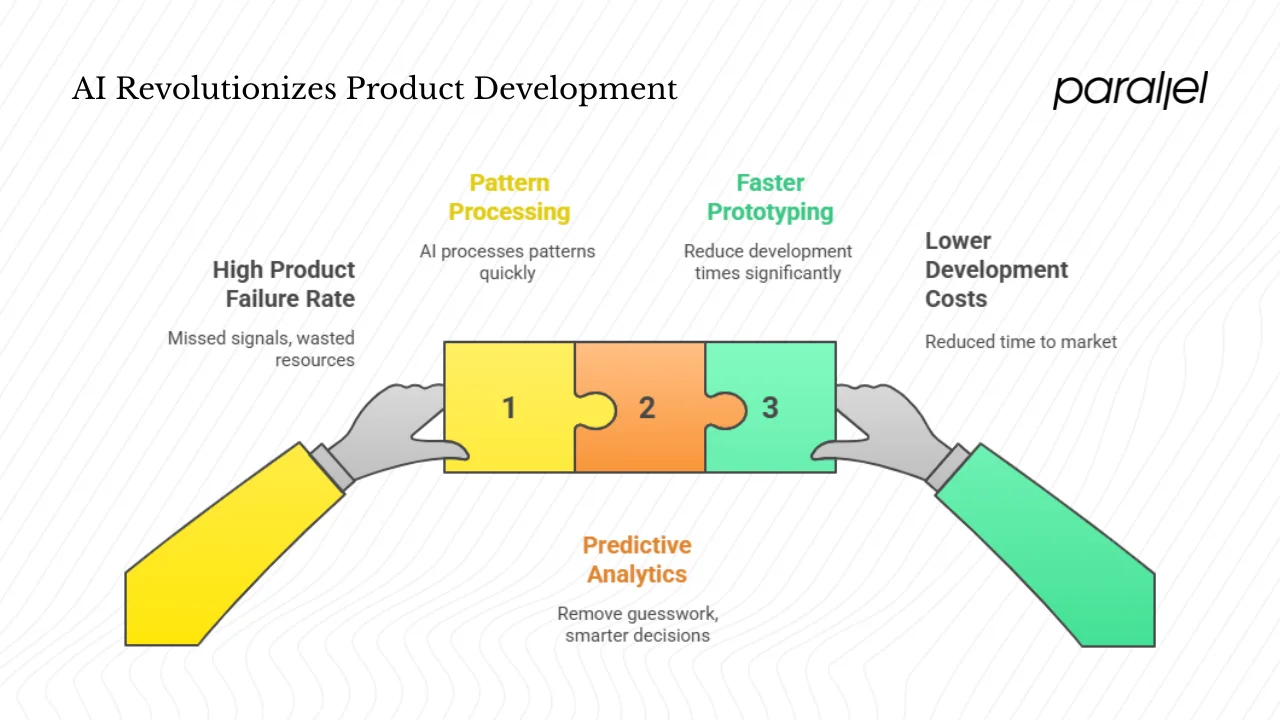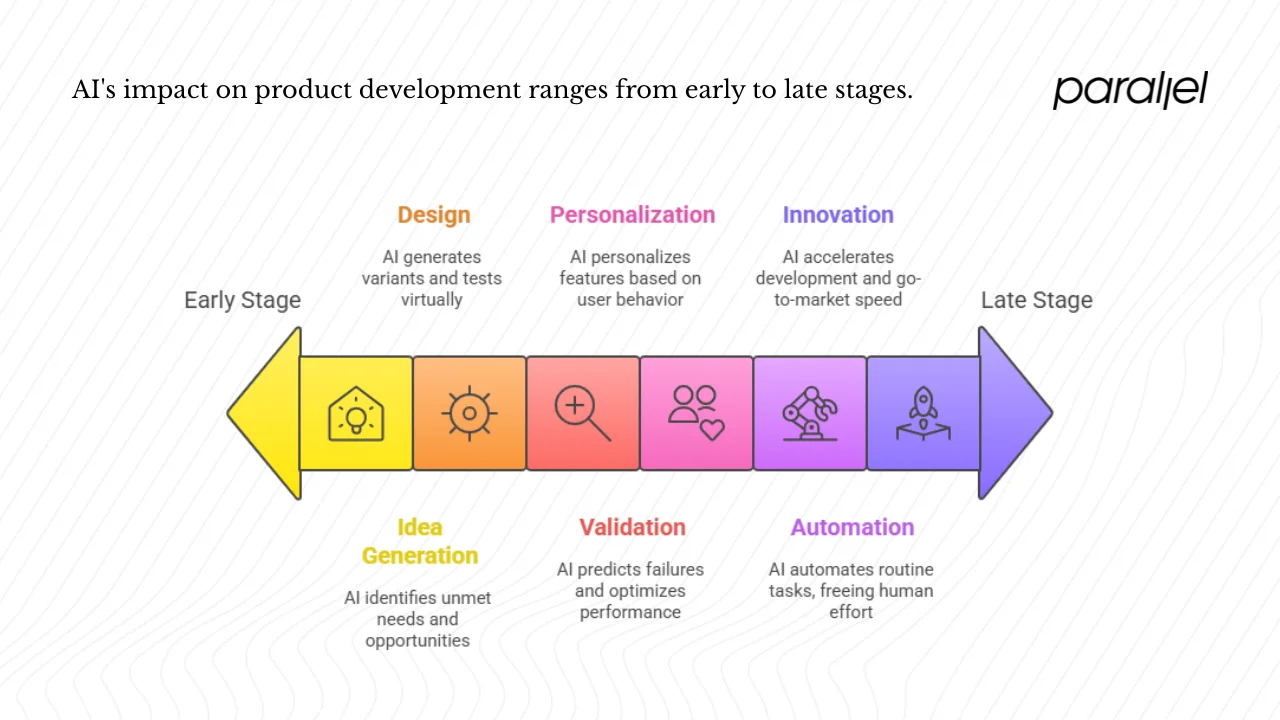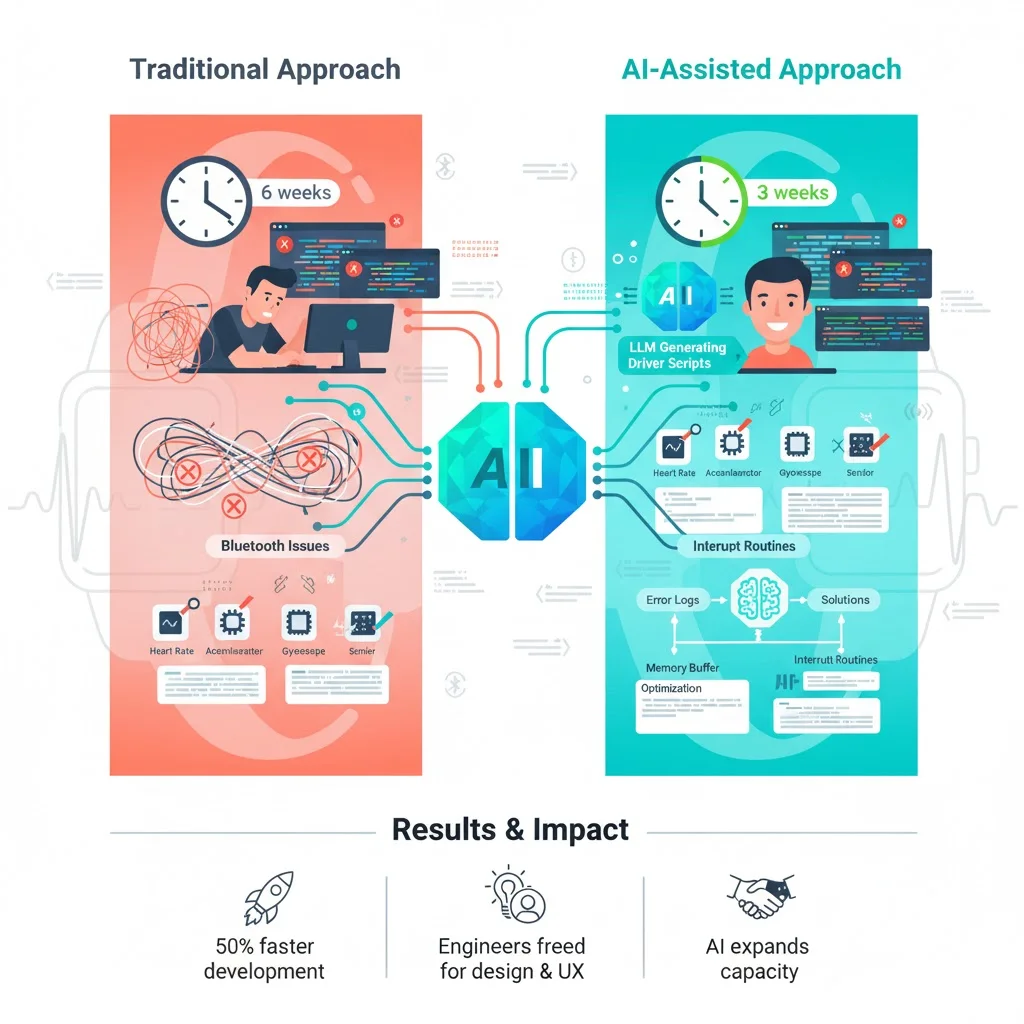How AI Is Changing Product Development: Guide (2025)
Learn how AI technologies are transforming product development processes, from ideation and prototyping to testing and optimization.

Imagine waiting two years for a new release, only to discover the market has moved on. That is how product cycles used to run: long research phases, manual prototyping, and endless iterations. Today, how AI is changing product development is altering those expectations. The ability of machines to process massive amounts of data and generate options means a concept can go from idea to launch in months instead of years. As someone who runs a design and product studio working with early‑stage startups, I’ve seen timelines shrink dramatically when artificial intelligence becomes part of the workflow.
In this article, I want to unpack how artificial intelligence is transforming product development, why it matters for founders and design leaders, and what practical steps you can take to benefit from it. We’ll touch on machine learning, automation, predictive analytics, user‑experience design, rapid prototyping, cost reduction, personalization, data‑driven decisions and accelerated innovation, all while keeping the needs of scrappy teams in mind.
The changing environment of product development
Building a product has always been an act of faith. Teams would often spend months on research, build a prototype, test it with a handful of users and hope it matched a real need. Slow prototyping, heavy manual iteration, and guesswork in understanding user needs add up to large cost overheads. According to a Virtasant article, around 40% of new products fail every year, wasting an estimated $215 billion in innovation spending in the United States. Many of these failures can be traced to missed signals: the market wants one thing while the design team builds another. Without concrete signals, you can pour resources into the wrong feature set.

Why artificial intelligence is a game changer:
This is where AI is changing product development. Artificial intelligence can process patterns at a scale and speed that humans simply can’t. Virtasant reports that early adopters have cut development times by up to 50%. Their research also shows that companies applying artificial intelligence to product development reduce time to market by 20–40% and lower development costs by 20–30%. The mHub innovation lab notes that, traditionally, creating hardware has been slow and expensive, but artificial intelligence–driven tools now let teams move faster and stay closer to customer needs. This isn’t a buzzword: it’s an operational shift. Machine learning models and predictive analytics remove much of the guesswork, freeing human designers to work on high‑level decisions. When you’re a founder or product lead, time and money are your scarcest resources. The ability to make smarter bets faster is not a luxury; it’s the difference between survival and obsolescence.
Key areas where artificial intelligence impacts product development
Below are six areas where I see how AI is changing product development in practice. Each illustrates a different part of the product lifecycle.

1. Idea generation and market‑trend analysis
Finding the right problem to solve has always been the hardest part of building a product. Artificial intelligence changes this by turning the internet’s noise into structured signals. Natural language processing can sift through customer reviews, forum posts and social sentiment to surface unmet needs. Algorithms can also analyze market trends, competitor activity and patent filings to spot emerging opportunities. Researchers at MIT Sloan describe how innovation teams are using generative models to enhance ideation and gain market and customer insights. In my own work, we use models to scan product‑market fit surveys and identify unexpected clusters of feedback. This data‑driven approach doesn’t replace talking to users, but it helps us ask the right questions sooner.
2. Design and prototyping speed
Once you know what to build, getting from concept to prototype is where artificial intelligence shines. Generative design tools can produce thousands of variants based on material, cost and performance constraints. Advanced simulation software can test those designs under virtual conditions like stress, heat or wear. The mHub article explains that artificial intelligence and large language models are now acting as co‑pilots in hardware development, extending a founder’s capacity and unlocking insights that previously took weeks. In our studio, we’ve used generative tools to create dozens of interface layouts in a few hours, then used analytics to predict which ones might perform better before we build anything. That level of speed lets teams test multiple directions without burning through resources.
3. Predictive analytics for validation and optimization
Validation used to mean building something, releasing it and then bracing yourself for bugs and customer complaints. Predictive analytics changes that. By analyzing historical data and real‑time inputs, artificial intelligence can predict failures before physical testing begins. Scenario‑based simulations model how a product will perform under extreme conditions. The mHub article describes a faster “test–fix–deploy” cycle: developers spend less time searching for answers and more time fine‑tuning performance, leading to fewer costly surprises. In my experience, predictive models also highlight which user flows are likely to cause confusion or where users might drop off. That allows us to adjust before we ship and saves a fortune in support costs later.
4. Personalization and user‑experience design
Modern users expect products to adapt to their needs. Netflix, BMW and PepsiCo are among the companies using artificial intelligence to personalize features and design. Data‑driven insights allow teams to tune the experience for different segments—or even individuals—based on behavior patterns. At Parallel, we’ve built recommendation engines that surface the most relevant content to users, increasing engagement without adding complexity to the interface. When algorithms handle the heavy lifting, designers can focus on the emotional and aesthetic dimensions of the experience.
5. Automation and operational efficiencies
Another pillar of how AI is changing product development is automation. Routine tasks that once required human intervention—like code reviews, component testing and quality inspections—can now be handled by machines. mHub’s article shows how large language models help engineers debug code in real time and suggest fixes. Kanerika’s blog describes how computer vision systems detect microscopic defects and predictive maintenance monitors machinery to prevent unexpected breakdowns. This automation doesn’t eliminate jobs; it frees people from repetitive work, allowing them to focus on creativity and strategy. We’ve seen it reduce testing cycles from weeks to days, slashing overhead while improving quality.
6. Innovation acceleration and go‑to‑market speed
When you combine rapid ideation, generative design, predictive analytics, personalization and automation, you get the real prize: speed. Virtasant reports that artificial intelligence can cut development time by up to 50%. The same article notes that using machine learning and advanced analytics reduces time to market by 20–40%. At mHub, a team developing a wearable device used an LLM to generate driver scripts and debug issues, cutting the firmware cycle from six weeks to under three. These numbers aren’t theoretical. At Parallel, we’ve seen small teams outpace much larger competitors because they use artificial intelligence tools to test and iterate faster. Faster feedback loops mean you can push a beta out sooner, learn from real users and refine your proposition while others are still building their first prototype.
Implications for founders and design leads at startups
Artificial intelligence isn’t a magic wand; it’s a shift in how we think about building products. Here are some implications and tactics.

1) Strategic shifts to adopt
Stop treating artificial intelligence as a Bolton feature. Instead, weave it into every stage. Use data‑driven decision making to prioritize features and avoid building what nobody wants. Look for tasks where models can support creativity rather than replace it—idea generation, prototype evaluation and early user research are all areas where the technology shines. Ask yourself not just how AI is changing product development, but how it will change your own process.
2) Organisational and workflow changes
Artificial intelligence forces interdisciplinary collaboration. Product managers, designers, data scientists and engineers need to work together much earlier in the process. Shorter prototyping cycles mean your team must be ready to test, gather feedback and iterate every few days, not months. Create shared artefacts—decision documents, hypotheses and datasets—that keep everyone on the same page. And build basic literacy around machine learning in non‑technical roles so design and product leaders can ask the right questions.
3) Resource and cost advantages
For early‑stage startups, the economic benefits are clear. McKinsey’s analysis (as cited by Virtasant) shows that companies using artificial intelligence can reduce time to market by up to 40% and cut development costs by 20–30%. Automation reduces labor hours in testing and quality assurance. The mHub article notes that AI‑assisted debugging allows teams to focus on other aspects, effectively expanding capacity. When budgets are tight, these savings can mean the difference between shipping and shutting down.
4) Risks and considerations
Every tool has downsides. Artificial intelligence is only as good as the data you feed it. Kanerika’s blog emphasizes that robust data collection and management practices are the foundation for effective systems. Biased or low‑quality data will lead to poor recommendations, wasted effort and potentially harmful decisions. Ethics matter: privacy, transparency and fairness cannot be afterthoughts. There is also the risk of “AI‑washing”—touting features as intelligent when they’re not. Finally, integrating these tools requires change management. Your team may need to learn new skills and adapt to new workflows. Plan for training and give people time to adjust.
Practical steps for getting started
Here’s a simple playbook for founders and product leaders who want to apply how AI is changing product development:
- Identify high‑impact areas. Start by pinpointing where artificial intelligence could add value—ideation, prototyping, user research or quality control.
- Assess your data. Make sure you have enough quality data to feed models, whether it comes from user interviews, usage logs or market research.
- Choose the right tools. Decide whether to build custom models or integrate off‑the‑shelf services. Early on, off‑the‑shelf generative tools and analytics platforms will be sufficient.
- Run pilots. Test the technology on a small feature or workflow. Measure impact in terms of time saved, cost reduction and user outcomes.
- Iterate and scale. Once you see results, expand the use case, but keep an eye on data quality and ethical considerations.
- Align teams. Hold regular reviews to make sure product, design and engineering teams understand how the models work and how to interpret their outputs.
Case studies and real‑world examples
Stories make the benefits concrete. Here are three examples that show how AI is changing product development in different industries.
BMW’s assembly line
BMW Group uses sensor technology and machine learning in its vehicle assembly process. Camera systems and sensors along the line conduct visual and acoustic inspections, detect anomalies and provide real‑time feedback. At the Spartanburg plant, artificial intelligence manages the placement of metal studs by robots, saving the company over $1 million per year and enabling a five‑fold performance improvement. The result is better quality and a shorter time to market for new models. For a founder, the lesson is that even in highly complex hardware environments, automation plus analytics deliver measurable gains.

Wearable health device firmware
A startup building a wearable health tracker faced the usual firmware challenge: writing drivers for sensors and managing Bluetooth communication. Instead of spending six weeks on manual coding, the team used a large language model to generate an initial driver script with correct register configurations and initialization sequences. When they hit repeated Bluetooth disconnects, they fed the error logs back into the model, which suggested memory buffer adjustments and restructuring the interrupt routines. The result was a functional firmware stack in under three weeks. Freed from debugging, the engineers could focus on industrial design and user testing. It’s a clear example of artificial intelligence expanding capacity rather than replacing human ingenuity.

Food and biochemical formulation
Food companies like Corbion use simulation and predictive analysis to identify and select ingredients for new products. Ashley Robertson, Corbion’s global marketing director, explains that artificial intelligence can expedite formulation and enable faster iterations based on feedback. In industries where compliance and safety testing are strict, speeding up formulation without compromising quality creates a big advantage. Startups working on consumer packaged goods can use similar approaches to test flavor combinations, shelf stability or nutritional profiles in silico before entering a kitchen.

Future trends and what’s next
Looking ahead, we’re just scratching the surface of how AI is changing product development. Emerging capabilities will continue to reshape the process.
- Generative design and automated iteration. Kanerika’s article describes automated design iteration and component optimization, where algorithms evaluate multiple constraints simultaneously and propose optimal solutions. Future tools will allow designers to set high‑level goals and let software run countless variations until it finds the best trade‑offs.
- Closed‑loop feedback and personalization. As models ingest more real‑time usage data, they will adapt products automatically. This means not just recommending content but tweaking interfaces, features and even physical attributes on the fly.
- Digital twins and simulation. Virtual replicas of physical products and systems will allow teams to test changes without manufacturing a single prototype. Predictive maintenance and lifecycle optimization will become standard practice, saving costs and extending product lifespans.
- Ethical and regulatory considerations. As adoption grows, so will scrutiny. Future frameworks will require transparency around how decisions are made and ensure that outputs don’t discriminate. Access to data will also be subject to tighter controls.
- Skills and teamwork. The most innovative teams will combine human intuition with machine precision. Designers will need to understand machine learning concepts, and engineers will need to think about user experience. Those who adapt will create products that feel both personal and smart.
According to managers interviewed by MIT Sloan, generative tools help brainstorm ideas and refine designs by identifying promising concepts. Research cited in the same article found that humans come up with more useful ideas when brainstorming with generative models. Pairing human imagination with artificial intelligence will become the default mode of collaboration.
Conclusion
The “secret sauce” behind great products is changing. The old recipe relied on lengthy cycles, gut feelings and manual labour. Now, how AI is changing product development is rewriting that recipe. Artificial intelligence empowers us to generate ideas, test them quickly, personalize experiences, automate tedious tasks and, most importantly, accelerate our learning. For founders, product managers and design leads, embracing these tools thoughtfully means more than chasing hype. It’s about harnessing them to save time, reduce costs and build things people genuinely value. Begin by assessing your process, identifying where artificial intelligence can help, and then take small, measured steps. In doing so, you’re not only improving today’s products—you’re reshaping the way your company learns and creates.
Frequently Asked Questions (FAQ)
Q1. How will artificial intelligence change product development?
It will shrink timelines, cut costs and enable personalization. Generative tools help teams generate and test ideas faster. Predictive analytics catch issues before they surface. Automated testing and quality control improve reliability and free up people for creative work. Together, these shifts mean you can go from concept to launch in weeks rather than months.
Q2. What is the 10‑20‑70 rule in artificial intelligence?
Some practitioners suggest spending 10% of your effort on strategy, 20% on pilot projects and 70% on scaling the technology. The idea is to move quickly from theory to practice while dedicating most resources to integrating successful pilots into everyday workflows. I view it as a reminder to avoid endless planning and focus on real‑world experiments.
Q3. How can early stage startups use artificial intelligence in product development?
Start with research and concept validation: use natural language processing to mine reviews and forums for unmet needs. Deploy generative design tools to iterate prototypes quickly. Use predictive analytics to identify failure points before they cost you time and money. Measure the impact and scale up what works.
Q4. How is artificial intelligence revolutionizing development overall?
By automating tasks that were once manual, creating data‑driven insights and enabling products to adapt in real time. This transformation touches everything from idea generation to manufacturing. In practical terms, it reduces risk, speeds up feedback loops and frees teams to focus on what humans do best: creativity and critical thinking.








.avif)




